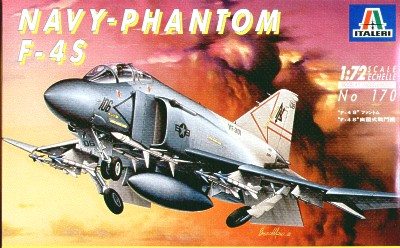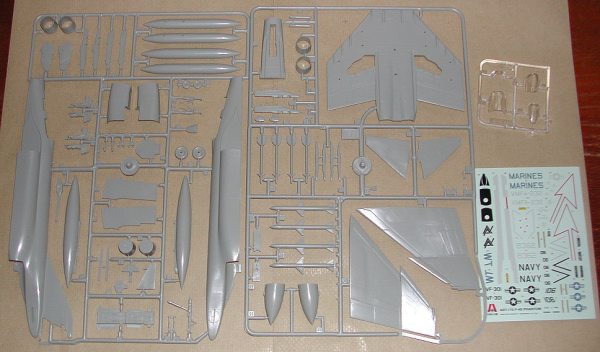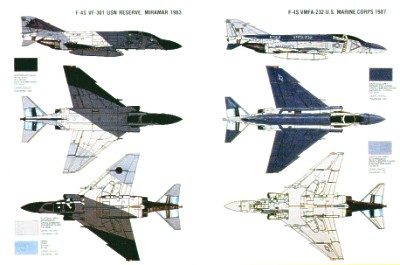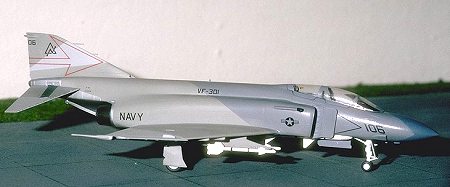
|
KIT: |
Italeri 1/72 F-4S Phantom II |
|
KIT # |
0170 |
|
PRICE: |
£5.99 |
|
DECALS: |
Two Aircraft |
|
REVIEWER: |
|
|
NOTES: |
Repop of the ESCI kit from the look of it. |

|
HISTORY |
The F-4S was essentially am updated, refurbished and slatted F-4J which had a short career with active fighter units.
The F-4S was born out of a Navy program to upgrade F-4J airframes in order to extend the service life until the Phantom could be replaced by the F-18 (USMC) and F-14 (USN). This was officially the “Airframe Change 599 Service Life Extension Program” (Catchy!) and was to be done at NARF at North Island, California. The first prototype F-4S (158360) made its first post conversion flight on 22nd July 1977.
Major changes were to be made following experience gained in Vietnam. To allow better close in dog-fighting and ground attack it was decided to introduce two-position leading edge maneuver slats. These would bring a 50% improvement in combat turning capability. This was a similar slat to that used on USAF F-4E’s, although with a longer fore and aft fence. There were considerable delays with this modification, which resulted in the first 47 being delivered without the slats, and then having to have them retrofitted at North Island or Cherry Point. The first conversion with slates was finally delivered to VFMA-251 in Nov 1979.
As the airframes were stripped and inspected various other improvements were also made, these included; visible external strapping on the wing spar; electrical systems being rewired with Kapton wiring; hydraulics replumbed using stainless steel tubing, and external ‘slime lights’ being fitted. Smokeless J79-GE-10B engines with low energy ignition and low smoke combustors were fitted; this finally got rid of the Phantom’s distinctive smoke trail. Finally a new digital weapons control system (AN/AWG-10B) was provided along with new UHF radios and a TACAN.
The F-4S was the last major Phantom variant. First deliveries were made to the USMC with VMFA-451 ‘Warlords’ receiving unslatted F-4S’s in June 1978; the first USN unit was VF-21 ‘Freelances’ at NAS Miramar. Eventually 13 USMC and 12 USN squadrons would fly the F-4S, the last USN examples being retired in May 1985 (VF-202) and the USMC in early 1992 (VMF-112), in my view a Sad day for this very venerable Aircraft.
|
THE KIT |

The kit comes on two gray plastic sprues and one clear one. These were loose in the box with my kit, but as from Ebay I am unsure if they are sealed with a new kit. (They are not. Italeri only seals the outer box. Ed) There is little or no flash present anywhere. One disappointment however is the number of ejection pin marks on the plastic. These are present on the cockpit sides, splitter plates, intake trunking, wheel wells, gear doors, and the missiles (both sidewinders and sparrows). While not impossible to remove they will take a lot of time and patience.
On to the kit itself, the Aircraft has raised panel lines, which are very fine with some engraved detail around the slats and flaps. The cockpit features 3 part ejection seats which while they don’t have any kind of belts do come with the top ejection handles which I hate making. The instrument panels and side consoles all come with raised detail. You will need to paint this as no instruments decals are provided.
Most of the main parts are, as you would expect them. Two fuselage halves with a center split, one-piece bottom wing and two-piece top wing. There is a small amount of detail moulded into the wheel wells and the landing gear struts are well moulded. The main gear doors are one piece which will have to be cut if you are doing the wheels down which most will. The rudder is actually supplied as separate piece.
Weapons and externals are very good. Supplied are a centerline large tank with moulded pylon, two wing tanks with separate pylons, 4 sparrow & 4 Sidewinders (appear to be AIM-9J’s) with separate launching rails.
The canopy is in 4 parts and is quite thin for the scale; the pieces are well moulded with no seam lines.
Instructions
These are quite comprehensive and fill 6 sides of A-5 on
one pull out sheet. Very little data on the aircraft is actually given. The
instruction give a layout of the sprues and then 9 construction steps followed
by a decal placement diagram. It is interesting to note all painting instruction
is via letter system with Model Master Numbers being given along with the
relevant FS Numbers (some other manufactures ie Tamiya could learn from this!).
Overall painting instructions are not given on the
 instruction sheet but the box
rear.
instruction sheet but the box
rear.
Decals / Paint Schemes
The decals appear to be quite thin and in register with
very little carrier film. Common decals are limited to Slime lights and the
vents on the intake trunking. Options are provided for two aircraft; the first
is for VF-301 USNR, Miramar 1983. This aircraft features a ‘Ferris’ type scheme
of diagonal bands of Intermediate blue (FS35164), Dark Gull Grey (FS36321) &
Flat Gull Grey (FS36440). Included in the decals for this scheme is a False
Cockpit for the underside. This decal will need to be cut if modeling the
aircraft with the gear down. (Your editor built a Fujimi F-4S using a Detail
and Scale sheet for one of these Ferris schemes and it was quite fetching. See
below)

The second is for VFMA-232 from 1987. This features the standard Dark Gull Grey/Light Gull Grey Topsides with flat gull gray on the underside.
|
CONCLUSIONS |
I have not made an Italeri kit for many years (I did build a few AFV’s a few years but I have since had treatment for that!), and was pleasantly surprised by the quality of this kit. In fact this was purchased as a job lot on ebay with the intention of being sold on afterwards, but I have decided to build it despite being a strictly 1/48th man.
I would recommend this kit. It looks fairly simple and anyone with even basic skills should be able to make a good job of it.
Review courtesy of me, my wallet and Ebay.
If you would like your product reviewed fairly and quickly by a site that has well over 150,000 visitors a month, please contact me or see other details in the Note to Contributors.
Back to the Previews Index Page